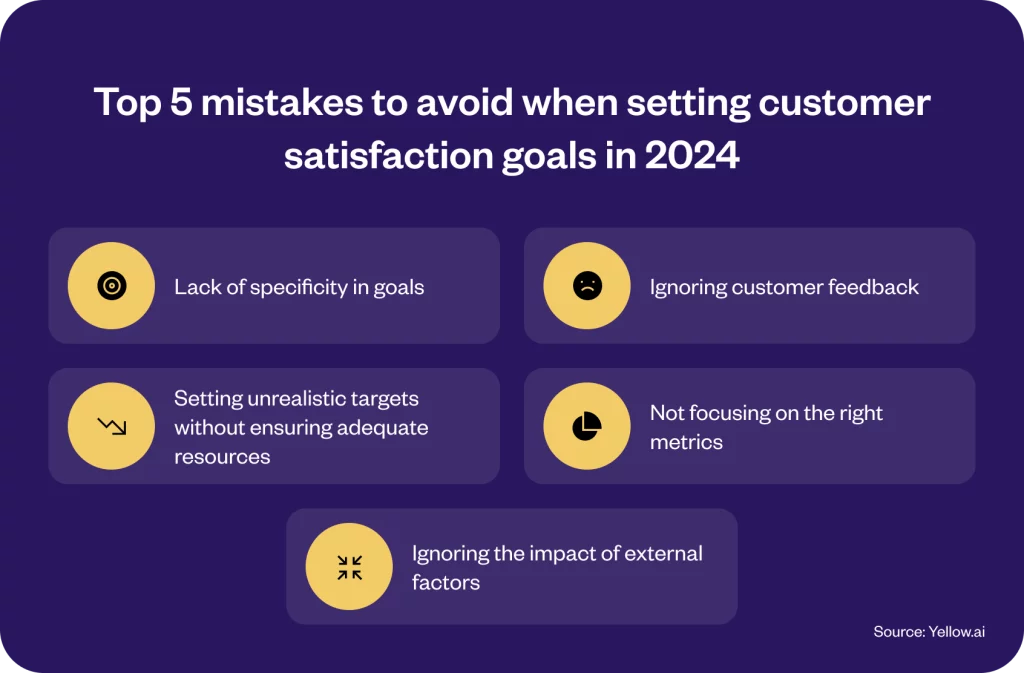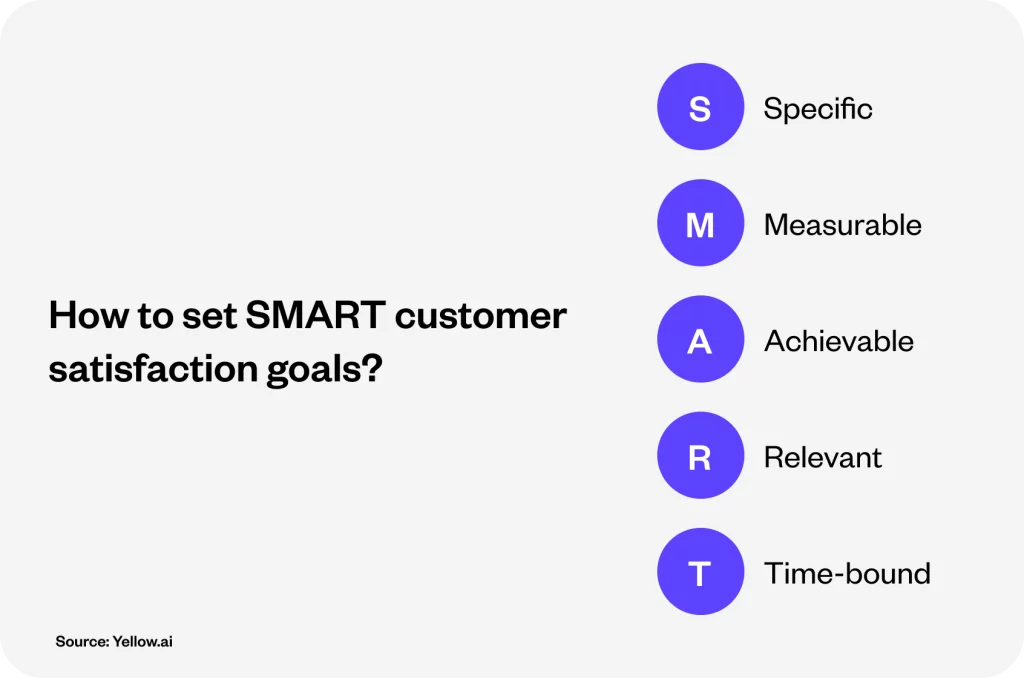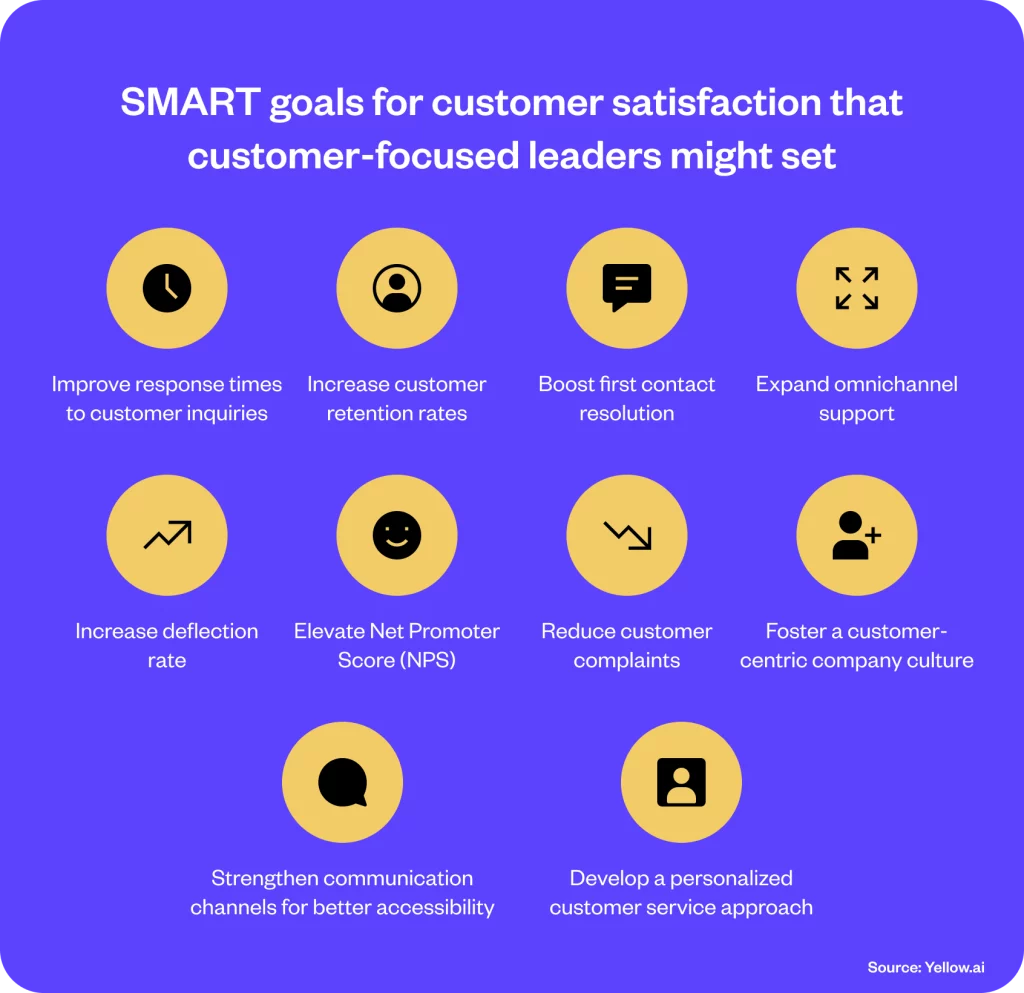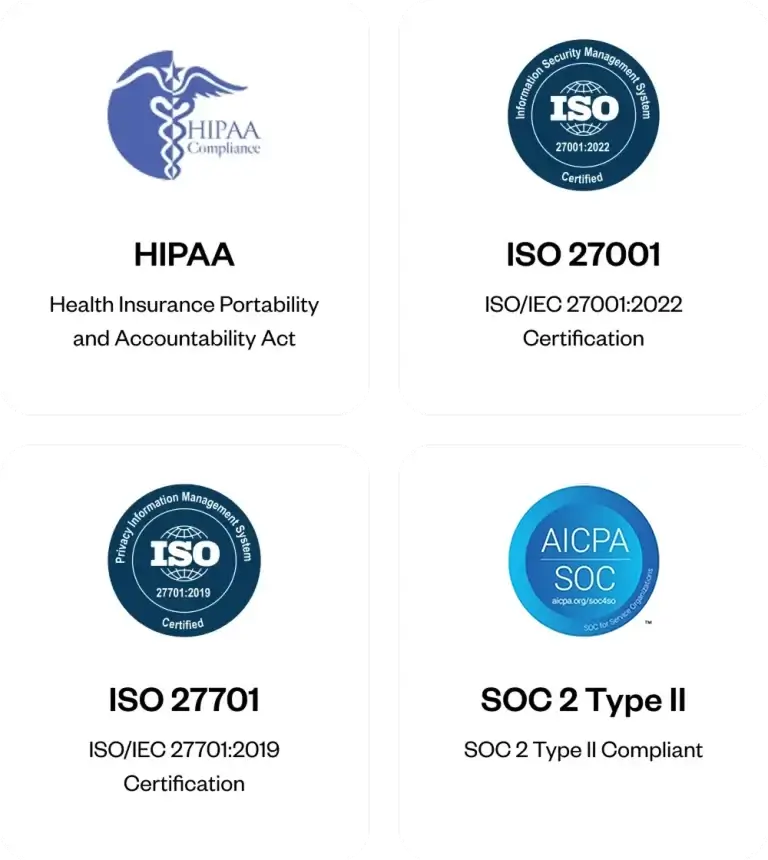Customer satisfaction goals are a critical determinant of business success or failure. These goals are instrumental in enhancing the customer satisfaction score — a pivotal indicator that reflects a customer’s loyalty, level of satisfaction, and overall quality of customer experience.
A Zendesk survey reveals a stark reality: more than 50% of customers are willing to switch to a competitor following just one unsatisfactory experience. This statistic underscores the paramount importance of customer satisfaction in today’s competitive environment.
In this blog, we’ll guide you through these common missteps and provide practical advice to avoid them, ensuring your goals are both realistic and aligned with your business strategy. By sidestepping these pitfalls, you can set your business up for improved customer relationships and sustained success.

1. Lack of specificity in goals
The mistake:
One of the most common pitfalls in setting customer satisfaction goals is the lack of specificity. Vague goals such as “improve customer satisfaction” are not actionable because they do not provide clear direction or measurable outcomes. Without specificity, it’s difficult for teams to focus their efforts or gauge progress effectively.
How to avoid it:
To avoid this mistake, define the goals precisely. Use the SMART criteria to ensure goals are Specific, Measurable, Achievable, Relevant, and Time-bound. For example, instead of the goal to “improve customer satisfaction,” a more specific goal could be “increase customer satisfaction scores by 10% within the next quarter by implementing a new feedback system.”
Examples:
Service Industry: A service provider could aim to “increase first-call resolution rates from 70% to 95% within six months by leveraging the latest AI solutions.”
By clearly defining what success looks like, your organization can create actionable roadmaps, align team efforts, and measure progress effectively. This approach not only clarifies expectations but also motivates employees by providing them with concrete targets to strive towards.
2. Ignoring customer feedback
The mistake:
Ignoring customer feedback is a critical oversight when setting customer satisfaction goals. In today’s multi-channel environment, where feedback comes through various platforms in large volumes, businesses often overlook this rich source of data. Not utilizing this feedback means missing out on key insights that could guide better service improvements.
How to avoid It:
Leverage technology to aggregate and analyze feedback across all channels efficiently. Implement systems that can handle large data volumes and provide actionable insights. Establish a continuous loop where feedback directly influences business strategies and goal setting.
Examples:
Travel industry: A travel agency might use ML tools to analyze customer feedback from online booking platforms and social media to identify common issues with booking processes or desired features in travel packages.
By effectively harnessing feedback from all available channels, companies can ensure that their customer satisfaction goals are both relevant and dynamically aligned with customer expectations. This approach not only enhances the customer experience but also drives strategic business improvements.
3. Setting unrealistic targets without ensuring adequate resources
The mistake:
A common mistake in setting customer satisfaction goals is establishing ambitious targets without investing in the necessary resources. Unrealistic goals, especially without the proper tools, technology, or workforce, can lead to team burnout and demotivation, undermining the very objectives meant to boost customer satisfaction.
How to avoid it:
Ensure that goals are realistic by aligning them with available resources. Conduct a thorough resource assessment before setting new targets. This includes evaluating the current technology stack, staff capabilities, and financial resources. Goals should challenge the team but remain achievable with the existing or reasonably expected resources.
Examples:
Utilities: A retail company should set customer response time improvement goals only after ensuring it has enough trained customer service agents or after empowering their human agent’s with the right automation technology to manage increased interactions efficiently, and seamlessly.
By aligning goals with available resources and planning for necessary investments, companies can set more achievable objectives that encourage progress and morale, leading to genuine improvements in customer satisfaction.
4. Not focusing on the right metrics
The mistake:
Relying on incorrect or inadequate metrics, particularly vanity metrics that look impressive but do not actually correlate with customer satisfaction, can mislead management efforts. Vanity metrics often include data like page views or number of downloads, which don’t necessarily translate into real value or customer contentment.
How to avoid it:
Focus on actionable metrics that truly reflect customer experiences and directly impact business outcomes. Choose metrics that provide insights into customer loyalty, service quality, and problem resolution effectiveness.
Examples:
Retail sector: Instead of just tracking foot traffic, a retailer might better measure customer satisfaction through metrics like repeat customer rates, customer feedback scores, and post-purchase support satisfaction through all their online and offline channels.
Incorporating the right metrics ensures that your strategies are aligned with enhancing real customer satisfaction and avoiding the trap of misleading vanity metrics. This approach leads to more meaningful improvements and sustainable business growth.
5. Ignoring the impact of external factors
The mistake:
Often, businesses set customer satisfaction goals without considering external factors such as economic conditions, technological changes, shift in user preferences, or competitive actions. Ignoring these can lead to unrealistic expectations and strategies that do not adapt to the changing environment.
How to avoid it:
Regularly assess the external environment and adjust your customer satisfaction strategies accordingly. This includes staying informed about economic shifts, industry advancements, and any regulatory changes that could affect customer preferences and behaviors.
Examples:
Automotive sector: By leveraging data analytics and AI-driven forecasting tools, automotive businesses can adjust their product offerings, marketing strategies, and customer service approaches to align with current market demands and expectations. For instance, during a rise in eco-consciousness, an automotive company might emphasize their electric vehicle options more prominently, tailoring communications and promotions to attract environmentally aware consumers.
By being mindful of external influences and incorporating this awareness into your strategy, your customer satisfaction goals will be more realistic and responsive to the conditions that impact your customers’ experiences and expectations.
How to set SMART customer satisfaction goals?
Now that you’re aware of the common pitfalls to avoid when setting customer satisfaction goals, it’s time to focus on establishing the right objectives that will truly enhance your customer relations and drive your business forward. The key is to make these goals SMART: Specific, Measurable, Achievable, Relevant, and Time-bound. This section will guide you through each aspect of the SMART criteria, providing you with the tools to set effective and actionable customer satisfaction goals.

In the following paragraphs, we’ll explore how to craft goals that are not only clear and precise but also aligned with your strategic business outcomes and adaptable to changing customer expectations.
- Specific: Start by defining what you want to achieve with as much precision as possible. Instead of setting a vague goal like “improve customer service,” aim for a specific target, such as “increase customer service satisfaction ratings by 10%.”
- Measurable: Your progress and knowledge of when you’ve achieved your goal must be quantifiable. For instance, customer satisfaction scores (CSAT), Net Promoter Scores (NPS), or customer effort scores (CES) can be used as metrics to measure success.
- Achievable: Your goal should stretch your abilities but remain possible. Analyze your current customer satisfaction levels and resources to ensure the target is attainable. Setting an unrealistic goal, like aiming for 100% satisfaction within a month, might demotivate your team when it proves unfeasible.
- Relevant: Ensure the goal aligns with your business objectives and addresses customer needs and feedback. A goal that significantly impacts customer loyalty or reduces churn is more appropriate than one that doesn’t directly affect your business’s bottom line or customer experience.
- Time-bound: Assign a deadline to your goal to create a sense of urgency and motivate your team. Whether it’s three months or a year, a clear timeline helps prioritize tasks and resources.
By integrating the SMART framework into your strategy, you can set clear, actionable goals that enhance customer satisfaction. Remember, the objective is not just to set goals but to create a roadmap for achieving them, thereby transforming challenges into milestones of success.
SMART customer satisfaction goals to improve loyalty and reduce churn
Loyalty and churn are two sides of the same coin, with the balance heavily influenced by how well a business meets and exceeds its customers’ expectations. Embracing SMART goals within your customer satisfaction strategy is more than a best practice; it’s a transformative approach to cementing customer loyalty and minimizing churn.

Here are some sample SMART goals for customer satisfaction that customer-focused leaders might set:
- Improve response times to customer inquiries: Commit to reducing response times by XX% within the next quarter with CRM optimizations, automation deployments, while providing clear metrics and a deadline to measure progress effectively.
- Increase customer retention rates: Improve customer retention rates by XX% in one year by personalizing customer interactions and offering tailored promotions based on customer purchase history.
- Boost first contact resolution: Achieve a first contact resolution rate of XX% within the next nine months by deploying advanced AI-powered automation for customer service function.
- Expand omnichannel support: Implement and optimize three new customer service channels (e.g., live chat, social media, mobile app) in the next twelve months to provide customers with more ways to reach out for support.
- Increase deflection rate: Specific and Measurable – Set a goal to increase the deflection rate to self-service tools by XX% over the next six months by enhancing the accessibility and effectiveness of online FAQs and AI chatbots. This targets the efficient use of resources and aims to decrease the number of routine inquiries reaching live agents, making the service process more efficient.
- Elevate Net Promoter Score (NPS): Aim to increase the NPS by XX points within one year by leveraging AI-driven analytics to personalize interactions and predict customer needs, enhancing overall customer loyalty.
- Reduce customer complaints: Target a XX% reduction in customer complaints over the next six months by using AI to analyze service interaction data and identify areas for improvement.
- Foster a customer-centric company culture: Develop a culture that prioritizes customer feedback by implementing AI tools that collect and analyze customer sentiments in real-time, integrating this data into daily operations.
- Strengthen communication channels for better accessibility: Improve the accessibility of communication channels by XX% within nine months by integrating AI-powered chatbots and voice assistants that provide 24/7 customer service across all platforms.
- Develop a personalized customer service approach: Increase customer satisfaction by XX% over the next year through AI-enhanced personalization strategies that tailor interactions based on individual customer preferences and history.
How can Yellow.ai help to improve your customer satisfaction score?
Leveraging cutting-edge technology to enrich the customer experience is the key to unlocking unparalleled customer satisfaction. Yellow.ai stands at the forefront of this revolution, offering a next-generation AI-powered suite to transform the customer journey. By automating customer service interactions and personalizing the customer experience, Yellow.ai ensures your brand remains competitive in a rapidly evolving marketplace. This section delves into how Yellow.ai’s comprehensive AI solutions can be a game-changer in improving your customer satisfaction score.
24/7 customer support automation
By providing round-the-clock customer support, Yellow.ai ensures no customer query goes unanswered, significantly reducing response times—a key metric positively correlated with higher customer satisfaction scores.
Personalized customer interactions
Yellow.ai’s AI analyzes customer data to tailor conversations and solutions, leading to a more personalized service. This personalization can increase customer satisfaction scores by making interactions more relevant and meaningful.
Seamless omnichannel experience
Offering a consistent and smooth experience across all platforms, from social media to live chat, Yellow.ai can improve the Customer Effort Score (CES), directly influencing overall satisfaction.
Proactive customer engagement
Through predictive analytics, Yellow.ai can initiate proactive service actions, increasing the Net Promoter Score (NPS) by anticipating and solving customer issues before they escalate.
Real-time customer feedback collection
Implementing immediate feedback loops helps quickly identify and address areas of dissatisfaction, allowing for agile improvements that can reflect an upward trend in satisfaction metrics.
Data-driven insights and continuous improvement
Leveraging AI to analyze customer interaction data, Yellow.ai provides insights that can guide strategic service delivery improvements, leading to sustained enhancements in customer satisfaction scores.
Conclusion
The complexity of customer expectations requires a strategic approach that emphasizes the importance of setting and diligently working towards customer satisfaction goals. These goals are vital for enhancing customer loyalty, reducing churn, and improving satisfaction scores.
By leveraging AI-powered customer service tools, businesses can automate customer service interactions and personalize the customer experience, making significant strides in customer satisfaction. With Yellow.ai, enhancing your customer satisfaction score becomes an attainable target, positioning your brand for success in a competitive landscape.
Achieve SMART customer satisfaction goals with Yellow.ai


















